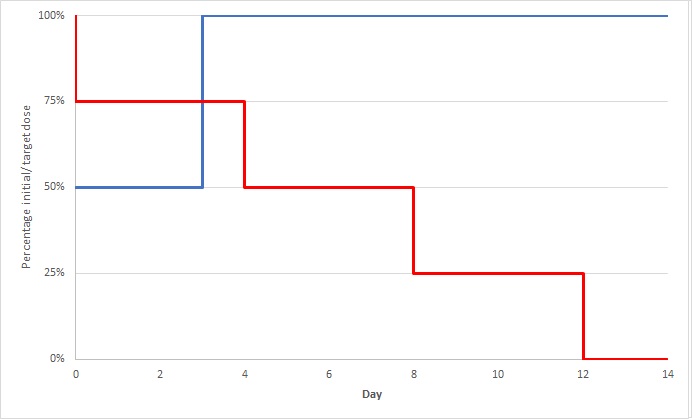Risperidone-Partial antagonist
| ||||||||||||||||||||||||||||||||||||||||||
| ||||||||||||||||||||||||||||||||||||||||||
Switch medication from Risperidone to Partial antagonist[4][5]
Partial antagonist is a collection of antipsychotic drugs having similar properties with respect to switching. A switch to member of the 'partial antagonist' group from anotherdrug should be read as partial antagonist-anotherdrug. Similarly, a switch from a member of the 'partial antagonist' group to anotherdrug should be read as anotherdrug-partial antagonist.
- Day 1-4: approx. 75% of initial dose
- Day 5-8: approx. 50% of initial dose
- Day 9-12: approx. 25% of initial dose
- Day 13: stop
- Day 1-3: start 50% of target dose
- Day 4-7: target dose
- During this switch you could monitor ECG, especially in patients prone to QT-conduction problems.
- There is a possibility of QT interval prolongation.[6]
- ↑ 1.0 1.1 KNMP; Informatorium Medicamentorum 2023; Monografie "risperidon" (Dutch)
- ↑ Woods SW; Chlorpromazine equivalent doses for the newer atypical antipsychotics J Clin Psychiatry 2003;64:663-667
- ↑ 3.0 3.1 The Lundbeck Institute; Psychotropics; Terminal Plasma Half-lives
- ↑ Switches are based on literature references on this page and expert opinions of the authors. The authors have used pharmacokinetic and receptor affinity properties to determine the switch schedules
- ↑ Stahl, S. M. (2013). Stahl's essential psychopharmacology: Neuroscientific basis and practical applications (4th ed.). Cambridge University Press.
- ↑ Stöllberger C, Huber JO, Finsterer J, Antipsychotic drugs and QT prolongation. Int Clin Psychopharmacol. 2005 Sep;20(5):243-51.
The editors of psychiatrienet.nl take the greatest care to provide up-to-date and accurate information on this site. Nevertheless, mistakes and omissions cannot be entirely excluded. No rights devolve from the information provided. The editors and other providers of information to this site accept no responsibility for the content of this site or for the information provided therein; neither do they accept responsibility for possible damages which may derive from the use of the information on this site or from the linked sites. The editorial board accepts no responsibility for the content of the (linked) sites, for access to them, or for the products and services on these sites, nor for the occurrence of errors, viruses, and/or disruptions in service.
